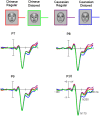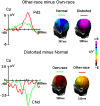The Role of Configural Processing in Face Classification by Race: An ERP Study
- PMID: 26733850
- PMCID: PMC4685067
- DOI: 10.3389/fnhum.2015.00679
The Role of Configural Processing in Face Classification by Race: An ERP Study
Abstract
The current study investigated the time course of the other-race classification advantage (ORCA) in the subordinate classification of normally configured faces and distorted faces by race. Slightly distorting the face configuration delayed the categorization of own-race faces and had no conspicuous effects on other-race faces. The N170 was sensitive neither to configural distortions nor to faces' races. The P3 was enhanced for other-race than own-race faces and reduced by configural manipulation only for own-race faces. We suggest that the source of ORCA is the configural analysis applied by default while processing own-race faces.
Keywords: ERPs; configural processing; face perception; other-race faces.
Figures




Similar articles
-
The Role of Spatial Frequency Information in Face Classification by Race.Front Psychol. 2017 Aug 24;8:1152. doi: 10.3389/fpsyg.2017.01152. eCollection 2017. Front Psychol. 2017. PMID: 28970809 Free PMC article.
-
The role of features and configural processing in face-race classification.Vision Res. 2011 Dec 8;51(23-24):2462-70. doi: 10.1016/j.visres.2011.10.001. Epub 2011 Oct 8. Vision Res. 2011. PMID: 22008980 Free PMC article.
-
The role of featural processing in other-race face classification advantage: an ERP study.J Integr Neurosci. 2014 Sep;13(3):435-46. doi: 10.1142/S0219635214500125. Epub 2014 Jun 17. J Integr Neurosci. 2014. PMID: 25164358
-
Cultural Differences in the Time Course of Configural and Featural Processing for Own-race Faces.Neuroscience. 2020 Oct 15;446:157-170. doi: 10.1016/j.neuroscience.2020.08.003. Epub 2020 Sep 4. Neuroscience. 2020. PMID: 32891705
-
Repetition effects in human ERPs to faces.Cortex. 2016 Jul;80:141-53. doi: 10.1016/j.cortex.2015.11.001. Epub 2015 Nov 18. Cortex. 2016. PMID: 26672902 Review.
Cited by
-
Epileptic Seizure Detection Based on EEG Signals and CNN.Front Neuroinform. 2018 Dec 10;12:95. doi: 10.3389/fninf.2018.00095. eCollection 2018. Front Neuroinform. 2018. PMID: 30618700 Free PMC article.
-
Do perceptual expertise and implicit racial bias predict early face-sensitive ERP responses?Brain Cogn. 2021 Feb;147:105671. doi: 10.1016/j.bandc.2020.105671. Epub 2020 Dec 22. Brain Cogn. 2021. PMID: 33360041 Free PMC article.
-
The role of task demands in racial face encoding.Sci Rep. 2022 Nov 7;12(1):18896. doi: 10.1038/s41598-022-19880-4. Sci Rep. 2022. PMID: 36344573 Free PMC article.
-
Rapid saccadic categorization of other-race faces.J Vis. 2021 Nov 1;21(12):1. doi: 10.1167/jov.21.12.1. J Vis. 2021. PMID: 34724530 Free PMC article.
-
Electrophysiological correlates of unconscious processes of race.Sci Rep. 2021 Jun 2;11(1):11646. doi: 10.1038/s41598-021-91133-2. Sci Rep. 2021. PMID: 34079021 Free PMC article.
References
-
- Caharel S., Montalan B., Fromager E., Bernard C., Lalonde R., Mohamed R. (2011). Other-race and inversion effects during the structural encoding stage of face processing in a race categorization task: an event-related brain potential study. Int. J. Psychophysiol. 79, 266–271. 10.1016/j.ijpsycho.2010.10.018 - DOI - PubMed
LinkOut - more resources
Full Text Sources
Other Literature Sources

